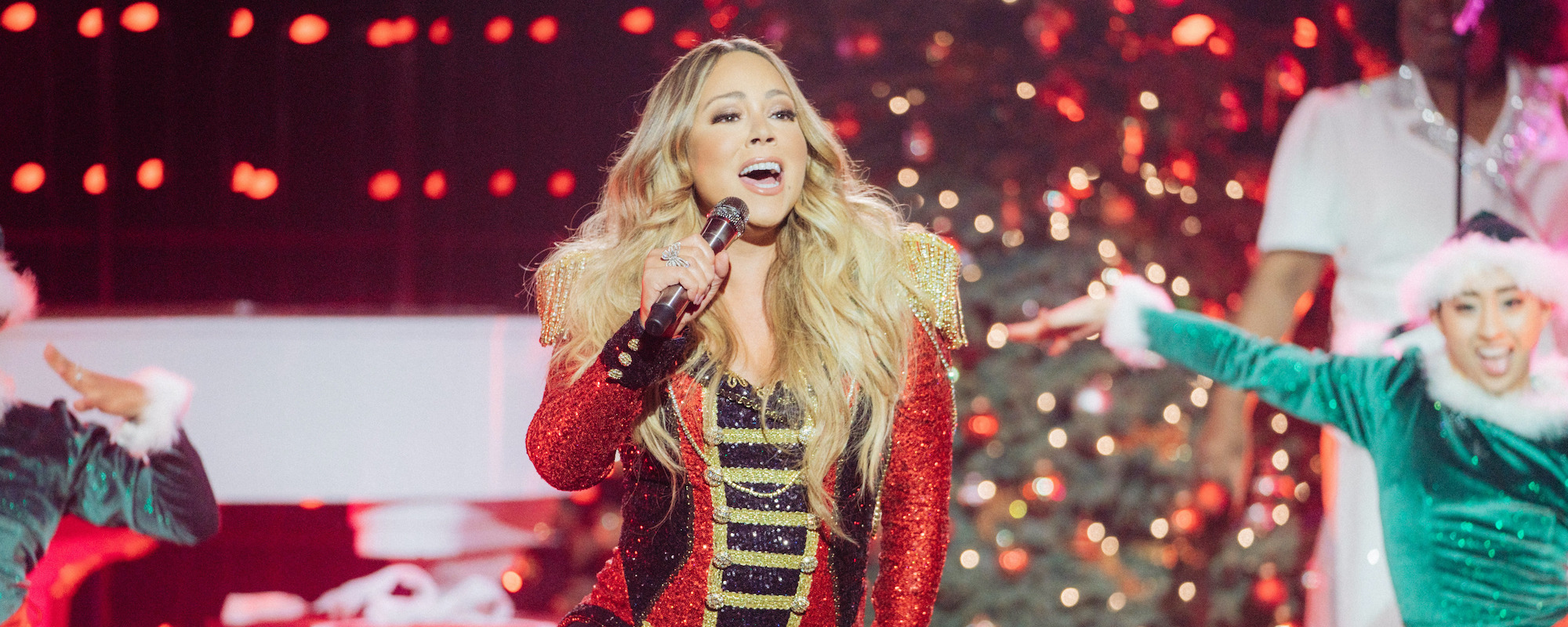Most of The 1975‘s At Their Very Best Tour revolves around a stage that looks like a two-story suburban home split in half, showcasing a honeycomb of individual rooms. Take away the music equipment and the place could easily be a Broadway set, as capable of hosting a play like Neil Simon’s Noises Off as an arena performance by one of the era’s biggest pop bands.
Videos by American Songwriter
George Daniel sits behind his drum kit in the home’s foyer. Adam Hann plays electric guitar in the living room. Jamie Squire—one of four musicians who have joined The 1975’s touring lineup, giving the band enough personnel to perform their layered pop songs without relying too heavily on pre-recorded tracks—stands at an upright piano on the upper level, while frontman Matty Healy crisscrosses the floor in front of his seven bandmates.
Healy’s startlingly sincere one minute and ironically obtuse the next, taking swigs from a flask that may or may not be empty, singing several songs with the theatricality of David Byrne before shifting gears and delivering “All That I Need To Hear” with a balladeer’s poise. All night long, he’s a fantastically engaging performer, whether he’s climbing onto the home’s slanted roof to sing “Me“—a deep cut that predates the band’s debut album—or shaking his hips during the chorus of “Somebody Else,” allowing the crowd to sing the melody without him. Being this sort of frontman involves balls and bombast, and Healy has both.
The Most Wonderful Time of The 1975
This tour may very well be The 1975 at their peak. The tour title, The 1975: Still…At Their Very Best, is cheeky, but also pretty accurate. The band has always been wildly creative, but they’ve never before struck this balance between craft and concept. The At Their Very Best show is high art disguised as pop music, and it’s taken The 1975 around the world, from a notorious performance in Malaysia—where Healy protested the country’s anti-gay laws by kissing his bassist and dubbing the local government “a bunch of fucking retards,” two moves that resulted in a ban from the country—to sold-out shows throughout Europe and North America.
Few contemporary pop bands actually play guitars these days, one of many distinctions that distinguish The 1975 from the majority of their synth-driven peers. Like INXS or Tears for Fears—two groups whose careers thrived during the 1980s, an era that serves as The 1975’s favorite source material—Healy and company often create pop music with the instrumentation of a rock ‘n’ roll band. Songs like “Happiness” and “Oh Caroline” feel like throwbacks from the final days of the Cold War, punctuated by syncopated guitar riffs that would’ve sounded appropriate on Thriller, or Peter Gabriel’s So. And it’s all built around neon-lit melodies that are plenty bright and bold. The 1975’s members were all born as the 1980s drew to a close, but they’ve become ambassadors of the decade’s music nonetheless; they’re creating the soundtrack to a John Hughes movie that doesn’t exist.
Controversy Sells, But…
Unwilling to simply play the hits, The 1975 kickstarted this tour in 2022 with a show-within-a-show concept that found Healy in character mode, playing an over-the-top man’s man. He ate raw meat, worked his biceps in front of a TV that blared footage of online rabble-rouser and accused human trafficker Andrew Tate, and invited audience members—both men and women—onstage to kiss him.
This storyline was praised by critics and immortalized by countless TikTok videos, but it also generated a good deal of controversy. Take away the meta storyline and what you had was a young tattooed man hamming it up beneath the stage lights, snogging fans who climbed over the barricade and into his Mojo Dojo Casa house. Without the context of the show itself, Healy looked like a man behaving very badly…and being applauded for it.
[RELATED: 5 Things to Know About The 1975]
That first leg of the tour was dubbed At Their Very Best. In late 2023, The 1975 launched the tour’s second leg, adding the “Still” to “…At Their Very Best,” and replacing some of the narrative aspects of the previous show with new technology. A giant LED screen was placed behind the house itself, serving as a digital sky one minute and a widescreen video wall the next. Gone are the push-ups in front of the TV set, the mid-set meal of uncooked lamb chops, and the snogging sessions with super-fans. In their place, the band has added a smaller stage in the middle of each arena, where The 1975 will occasionally appear to perform songs like “Paris.” It’s a move that helps shrink the distance between the main stage and the cheap seats in the back of the arena, and it feels generous.
…Connection > Performance Art
Each concert comes to a close with “People,” a raw, punky protest song that finds the band split between the B stage and the two-story house. George Daniel is still in the foyer, banging away at his drums, while his three bandmates thrash away in the distance, surrounded by fans who were only able to cough up the cash for GA tickets. It’s a stunning visual.
In America, The 1975 have never played so many arenas. They’re embracing the opportunity while looking for ways to keep the audience close. That’s what keeps them at their very best, still—the willingness to expand, to try, to attempt what might’ve once seemed preposterous.
Photo by Mauricio Santana/Getty Images













Leave a Reply
Only members can comment. Become a member. Already a member? Log in.